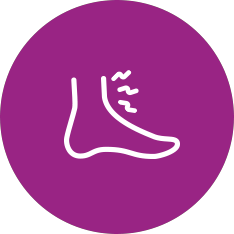New onset of ankle pain
I have new ankle pain, what should I do?
Do not panic. There are many reasons as to why your ankle can become painful and mostly these events are nothing to worry about. The ankle is a weightbearing joint supported by strong muscles and ligaments.
Pain can often be the result of irritation around the joint or soft tissue structures (like ligaments, tendons or muscles) or can sometimes be following a slip/trip/fall (trauma). You may get swelling and stiffness alongside the pain.
This can be easily managed by following some simple steps. Most new ankle pain will resolve in 6-12 weeks.

What else can I do?
You could also try these simple exercises to help maintain good movement and support the muscles around the ankle.
Exercises for new onset of ankle pain - EASY
Exercises for new onset of ankle pain - MODERATE
Exercises for new onset of ankle pain - ADVANCED
What if I have other symptoms or had a fall?
Please read the "symptoms to check" in the red box on the right of this screen first before using this page.
Symptoms to check
Click the plus sign to see a list of problems that could be a sign you may need to be checked urgently
Get advice from 111 now if:
- your ankle is very painful and you cannot put any weight on it
- you have direct injury to the ankle and it has become very swollen very quickly
- your ankle is badly swollen or has changed shape
- you heard a snap, grinding or popping noise at the time of injury
- you have a very high temperature, feel hot and shivery, and have redness or heat around the ankle – this can be a sign of infection
111 will tell you what to do. They can tell you the right place to get help if you need to see someone.
Go to 111.nhs.uk or call 111.
Immediate medical advice is available by contacting NHS 111


 Ankle
Ankle